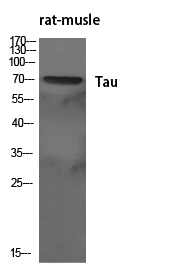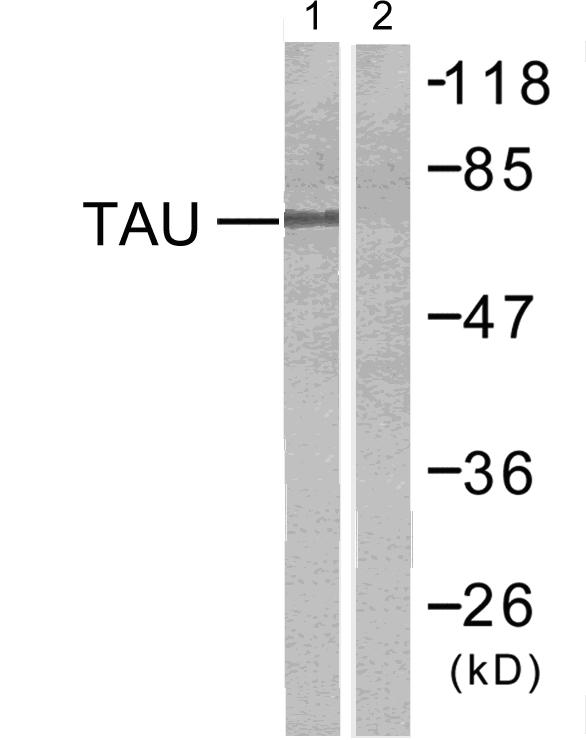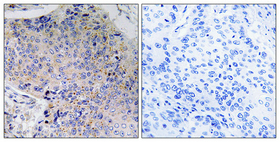


| WB | 1/500-1/1000 | Human,Mouse,Rat |
| IF | 咨询技术 | Human,Mouse,Rat |
| IHC | 1/50-1/100 | Human,Mouse,Rat |
| ICC | 1/50-1/200 | Human,Mouse,Rat |
| FCM | 咨询技术 | Human,Mouse,Rat |
| Elisa | 1/10000 | Human,Mouse,Rat |
| Aliases | MAPT; MAPTL; MTBT1; TAU; Microtubule-associated protein tau; Neurofibrillary tangle protein; Paired helical filament-tau; PHF-tau |
| Entrez GeneID | 4137 |
| WB Predicted band size | Calculated MW: 79 kDa; Observed MW: 79 kDa |
| Host/Isotype | Rabbit IgG |
| Antibody Type | Primary antibody |
| Storage | Store at 4°C short term. Aliquot and store at -20°C long term. Avoid freeze/thaw cycles. |
| Species Reactivity | Human,Mouse,Rat |
| Immunogen | The antiserum was produced against synthesized peptide derived from human Tau. AA range:496-545 |
| Formulation | Purified antibody in PBS with 0.05% sodium azide,0.5%BSA and 50% glycerol. |
+ +
以下是3篇关于Tau抗体的代表性文献及其摘要概括:
---
1. **文献名称**:*Tau pathology in Alzheimer disease and other tauopathies*
**作者**:Hyman, B.T., et al.
**摘要**:该综述讨论了Tau蛋白异常磷酸化与神经原纤维缠结(NFTs)在阿尔茨海默病中的作用,并介绍了多种Tau抗体(如AT8、PHF1)在检测磷酸化位点(如Ser202/Thr205)中的应用,强调其在病理诊断中的特异性。
2. **文献名称**:*Tau oligomerization in Alzheimer's disease: Therapeutic antibody development*
**作者**:Kondo, A., et al.
**摘要**:研究开发了一种新型单克隆抗体(TauO1),可选择性结合Tau寡聚体而非单体或纤维形式,实验表明该抗体能减少Tau介导的神经毒性,为早期诊断和靶向治疗提供了潜在工具。
3. **文献名称**:*Anti-tau antibodies for the treatment of tauopathies*
**作者**:Yanamandra, K., et al.
**摘要**:通过动物模型验证了一种人源化抗Tau抗体(HJ8.5),证明其能有效阻断病理性Tau在神经元间的传播,并减少认知功能衰退,支持Tau抗体在治疗tau蛋白病变中的可行性。
---
以上文献涵盖Tau抗体的诊断应用、机制研究及治疗开发,均发表于高影响力期刊(如*Nature Reviews Neurology*、*Neuron*等),可作为相关领域研究的核心参考。
Tau antibodies are essential tools in neuroscience research and diagnostics, primarily targeting the tau protein—a microtubule-associated protein critical for stabilizing neuronal microtubules in the central nervous system. Under physiological conditions, tau promotes microtubule assembly and maintains axonal transport. However, in neurodegenerative disorders collectively termed tauopathies (e.g., Alzheimer’s disease, frontotemporal dementia), tau undergoes abnormal post-translational modifications, such as hyperphosphorylation, leading to its aggregation into neurofibrillary tangles (NFTs). These pathological changes correlate with neuronal dysfunction and cognitive decline.
Tau antibodies are designed to detect specific tau isoforms, phosphorylation sites (e.g., pTau181. pTau231), or conformational changes associated with disease. Commonly used antibodies like AT8. PHF-1. and HT7 enable researchers to distinguish between normal and pathological tau in assays such as Western blotting, immunohistochemistry, and ELISA. In diagnostics, tau antibodies are pivotal in cerebrospinal fluid (CSF) biomarker studies, where elevated levels of phosphorylated tau reflect Alzheimer’s pathology. Recent therapeutic efforts also leverage tau antibodies (e.g., semorinemab, gosuranemab) to target extracellular tau species or block cell-to-cell propagation of tau aggregates in clinical trials. Despite challenges in specificity and cross-reactivity, tau antibodies remain indispensable for unraveling tau biology and advancing tau-targeted therapies.
×